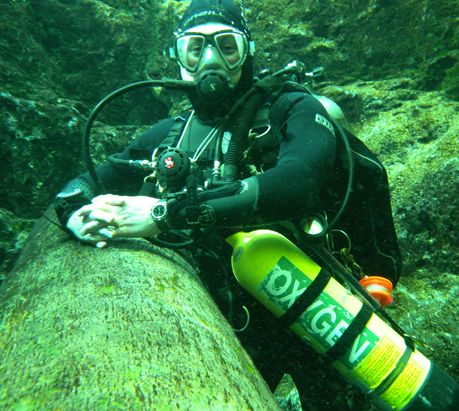As a boy, Homero Rivas II planned to live a wild life.
Growing up in South Texas, he climbed his first mountain with his father at 10 years old. He rode horses, camped, sailed and wind surfed. "My first memory was age three or four, being inside a cave," says Rivas.
But in August of 1990, a week into his second year at the Naval Academy in Maryland, his plans dramatically changed when he fell four stories down the center of a stairwell in a dorm building. The fall left him in a hospital bed for nearly a year. He broke two vertebrae in his back, his pelvis, his left hip. The fall collapsed his right lung, snapped his wrist and dislocated his shoulder and broke most of his right ribs. It also left him with nerve damage in his right leg.
For years he walked with a cane, and doctors had to fuse his left hip. But even though he couldn't bend at the hip, or run or bike, he was determined to find ways to be the adventurer he wanted to be as a child. "I didn't want to dwell on what could have been or what might of been, I wanted to focus on what I had and find a way to move forward with my life," he explains.
Rivas is now a doctor in Chattanooga specializing in non-surgical spinal medicine at Spine Surgery Associates. And, although he still walks with a noticeable limp, he's continued to challenge himself physically and mentally to keep the outdoors a part of his life. Most weekends he crawls or shimmies down into caves in Tennessee, Georgia and Alabama, an area which cavers refer to as TAG. And when he isn't poking around dark places underground, he travels to scuba dive in underwater caves, rivers, quarries and lakes throughout the Southeast.
And he's shot thousands of pictures of salamanders, rock formations, cave openings and passages he's found underneath the Earth, many of which he likes to show off to his coworkers. "I enjoy going places and seeing things that very few people get to see," he says. "That is where photographs come in. So many people can never see those things firsthand. When people ask me why I do what I do, that is where some of my motivation is."
After training in a 10-foot-deep pool, Rivas took his first dive off an oilrig on the Texas coast in 1993. Schools of fish gathering around the reefs swam right beside him. People told him he might see a dolphin or a barracuda.
Scuba diving quickly consumed him. He spent thousands of dollars on equipment, training and travel, finding his favorite spots in the U.S. were in North Central Florida and off the Texas coast.
A lot of people don't like diving in lakes, he says, but he just wants to be underwater. He doesn't mind diving in places that a lot of other divers avoid.
Three years after taking his first dive he was acting as a safety diver with two friends who were trying to explore caves at a Texas lake when he saw the opening of a cave for the first time. Catfish were floating on a crystal clear current in the middle of murky lake water. He wanted to know what was inside. A month later, he spent nine days getting his cave-diving certification.
"We were 110 feet underwater. The buoy put us down. I took one look at that cave entrance, a big gaping hole, and I thought, 'That is cool,'" he describes.
People die in underwater caves every year and Rivas knew the hobby would be dangerous. Regulators get yanked out of diver's mouths. Some divers get lost and run out of oxygen. Some get their equipment caught on a rock and can't pull out. Others panic and leave their equipment
too early. "A lot of cavers die with oxygen in their tank," he says.
Once, Rivas says he found himself unable to move because part of his harness was caught in a restriction 100 feet underwater. But he pulled hard enough to get it loose. "I thought, 'I am not going to be a statistic in this cave,'" he says. "If I have to rip my harness I am coming out."
In 2006, before moving to Chattanooga, he decided that he wanted to stretch himself to move beyond cave diving to dry caving. He tried rappelling in Alabama with a diving friend. He hadn't been on a rope since before his accident.
He said he was nervous to make the move, unsure of his physical limitation. "It took me a while to make that transition, saying, 'I'm going to try this,'" he says.
In Chattanooga, he met several dry cavers who had his same desire for exploration. The area where Tennessee, Georgia and Alabama meet is home to more than 7,000 caves. With so many places to choose from, it was easy to get back into the hobby.
What he found was unbelievable, he says. In every cave the water dissolved limestone in different ways. The color varies. So does the shape. Sometimes it looks like snowflakes, soda straws, drapery, bacon or a fried egg. There are cave crickets and bats too.
"There are so many amazing places in this world," he says. "There is so much left to find."
Physically, Rivas was changed by the accident. But in so many ways the accident just enforced who he already was. He knows a lot of people wouldn't have responded the way he did.
"One guy asked me how I do it," he says. "I think if anything it is the willingness to make changes and adapt to life. The key is dealing with things."


